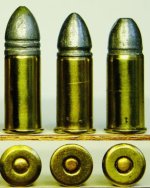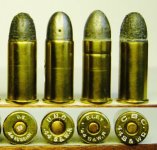I shot two black powder cartridge firearms Wednesday, cleaned them the same night. The first was an Uberti Schofield copy in 44/40. I pulled the cylinder, removed the center section and dumped it in some simple green and hot water, went back to the revolver and wiped off the residue from the recoil shield and area around the top latch, went forward and cleaned around the cylinder post and ran the first of around a dozen wet patches saturated with my cleaning solution that consists of water, Dawn liquid dish soap and water soluble mineral oil (mixed by the half gallon) They were pretty bad with fouling as expected but showed very little lead deposits. Cleaned, I followed with a couple dry patches, then ran a bore brush with Hoppe #9 a couple times, followed with clean patches and again saw only a very minute amount of lead streaking, very little. I put a coat of Barricade on everything and went back to my soaking cylinder. Good stiff nylon cleaning brush scrubbed everything external off, an oversized bottle brush down each hole a couple times, rinsed off, took it out to the shop and blew all residual water out with compressed air. Went back downstairs, ran a bore brush down each hole, clean patched to follow and a coat of Barricade in and out, reassembled the piece and put it away. I only fire that thing a couple times a year at the most and like it put away clean. I also shot another replica, this was another Italian copy of a Winchester Lightning pump in 44/40. It was much easier to clean and only needed serious work on the barrel, I followed the same dozen or so wet patches, scrubbed with a bore brush, Hoppes #9 and patches and finally Barricade, the interior of the receiver was quite clean, bolt face, etc. I always put a patch soaked with Hoppes and a dental tool into the nooks and crannies I can see, wiped down everything with Barricade and put that away as the other.
Back in the day hot water was the best way, soap if you had it. Heavy lubricants gum up revolver actions. With a buddy I made some bear oil that would stay fluid down to freezing or so, neats foot oil as well, Sperm Whale oil is out there...I have a can from Brownells, its special and only goes on my percussion and flintlock pieces. Cleaning muzzleloaders there is no lead because the ball is patched with cloth, only fouling. Rifled muskets are a different story but the speeds those things move at do not contribute to leading. Most of our issues are with fouling. Nearly every muzzle loader I shoot is wiped between each shot for continuity, also because I use a Teflon coated patch which requires a clean barrel. The only exception is a rifled musket and a smoothbore, I have found shooting Teflon patched round ball provides better accuracy with the rifled musket but traditionally they are shot with a Minie ball.


